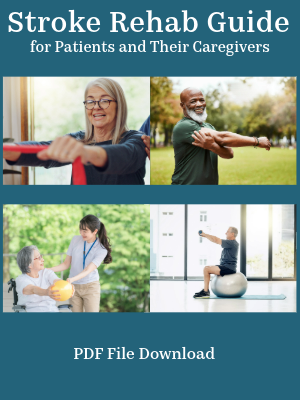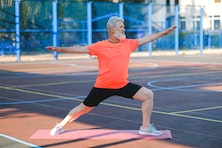Submissions from Readers
Shoulder out of socket
by Harold
(Oklahoma)
Question: What can you do if your shoulder has dropped out of its socket after a stroke?
Answer: Shoulder subluxation is a common occurence after stroke. Some treatment strategies used involve supporting the affected arm, electrical stimulation, strengthening, and hemiplegic arm slings (hemi slings).
You can support the affected limb by placing it on a tray or pillow when seated. There are special lap and half trays made for wheelchairs.
When walking, you might want to consider a hemi sling to help hold the humeral head in alignment. Many therapists will recommend hemi slings, however, most research hasn't proved or disproved that slings are beneficial for subluxation. Slings can be helpful in protecting the arm though since they will provide some support to a flaccid extremity and will alert others not to touch or pull on your arm. I often will recommend patients to wear slings in public but to remove them at home so the arm can be used more. It is best to avoid slings that bring your arm into internal rotation (i.e. elbow bent with hand placed on abdomen). The GivMohr sling developed by an occupational and physical therapist is a nice sling that does not pull the arm across the body but provides support. To research various slings, you can search "hemi-slings" or "slings for subluxation" on the internet. Talk to your therapist to see if a sling may be beneficial to you.
Electrical stimulation (e-stim) has been used on shoulder muscles to help decrease subluxation. Several studies have show e-stim to help reduce subluxation especially when combined with exercises. There are several contraindications for e-stim so check with your therapist and doctor to see if this is an option for you.
Click here to read or post comments
Shoulder Subluxation and GivMohr Sling
by Fran
Question: I had an AVM 30 years ago & often suffered from shoulder subluxation during long walks especially when fatigued. It is now a constant pain & my dr suggested to see a PT specialist in Strokes/AVM. What can I do meanwhile to ease the constant ache? I did buy a sling for long distance however, it is the one that keeps the arm across the abdomen which does not help the situation. I want to order the Givmohr Sling, but it states a therapist must position this. Any suggestions?
Answer: The GivMohr sling comes with instructions for donning so you should be able to figure out how to put it on. There is also instructions on their website as well as a sizing chart. The sizing chart can be found at www.givmohrsling.com/order.htm. Once you contact a therapist, you might try kinesiotaping. This isn't always effective, but I have met some patients that have been satisfied with taping, and it wouldn't hurt to try.
Subluxed Shoulder
Question:I have a patient with about a 1 1/2-2 finger subluxation. What can I do to treat it, and can I do shoulder ROM exercises? Their wrist and fingers are painful during ROM.
Answer: Range of motion exercises can be done with patients that have shoulder subluxation, but you have to be careful when you bring the arm above 90 degrees of shoulder flexion due to misalignment and impingement issues. It's easier to do shoulder range of motion with the patient in supine (lying on their back). You have to keep the shoulder in good alignment, reduce the subluxation, make sure the scapula upwardly rotates with overhead movement, and make sure to externally rotate the humerus if performing abduction (lifting to the side). I usually have the thumb pointing toward the ceiling for shoulder flexion. Do not force the arm up, pull on the arm, and stop if the patient experiences pain. I always mobilize the scapula prior to trying to doing shoulder range of motion which usually helps alleviate pain and allows for more shoulder movement. It is important to do elbow, wrist, and finger range of motion as well. If the patient is not doing range of motion, they will continue to be stiff and experience pain when someone attempts to move their arm.
Other methods to help with shoulder subluxation are to keep the arm supported, position arm in good alignment, kinesiotaping, and electrical stimulation in attempt to strenghthen the rotator cuff muscles.
PROM and subluxation from CVA
Question If there is a subluxation on a arm which is flaccid, do we perform range of motion or not?
Answer: It is okay in most cases to perform range of motion on a flaccid hemiplegic upper extremity. Of course one should always check with their therapist first to make sure there are no contraindications and also to learn the correct technique for range of motion. Range of motion should only be performed in a pain free range, the scapula should be upwardly rotating if shoulder range occurs above 90 degrees, the arm should not be pulled on, and the shoulder should be aligned correctly. In my opinion, the best position for passive range of motion of a flaccid arm is with the patient in supine. It is often difficult to achieve optimal alignment with the patient in sitting due to the paralysis and heaviness of the arm, and I find it can usually be done in supine without eliciting pain.
Moderate to severe shoulder subluxation after stroke
by roberta newman
(springfield, va, usa)
Question: Patient does not wear GivMohr sling because it cuts across her R lateral neck and she feels it contributes to neck spasms/pain later in the day. Because she does not like it, she does not wear it. What sling would you otherwise recommend? I am her home health OT. I was checking out the unilateral hemi sling, by Sammons Preston, which looks to be more comfortable. It features a single strap across the chest and under the R arm (L arm is affected limb) and encases the humeral head and proximal upper arm. What do you think? She is post-R CVA/L hemiplegia since january 2011.
I appreciate your counsel, as well as any treatment ideas (other than PROM, SROM, and e-stim, the latter which she cannot tolerate at all).
Answer: None of the slings will stop or cure subluxation so in my opinion I would use whatever the patient finds comfortable. If worn correctly, the GivMohr sling should not be on the neck but over the middle to lower portion of the upper trap. If she already has a GivMohr sling, I would make sure that it is fitting properly according to their website. The sling you have suggested may work fine, but you never really know until the patient tries it on. I don't even recommend wearing a sling when a patient is sitting around but rather to just prop the arm. If the person is ambulating frequently or for long distances then a sling may be more appropriate.
As far as other options, you might try kinesiotaping. Many patients like the kinesiotape and have less pain when it is applied. If they have sensitive skin, you can put milk of magnesia on the skin first and let it dry then apply the tape.
Some research has shown that e-stim may help reduce subluxation if it is done early and on a regular daily basis.
Subluxed Shoulder Treatment
Question: How soon should a subluxed shoulder be treated after a stoke has occurred?
Answer: You can begin at any time to take measures to help a subluxed shoulder. You want to minimize pain if present and position the arm to support it and prevent further stretching of weak structures. The one piece of advice I would give to someone though is not to obstruct the arm from moving. I am not a fan of slings that hold the arm across the body and restrict arm movement. These put the arm in an unfavorable position for stroke patients and prevent the patient from moving the arm. There are other ways to more effectively address subluxation which are addressed at www.stroke-rehab.com/shoulder-subluxation.html.
shoulder subluxation
by jeenat
(india)
Question: What is the best way for treating shoulder subluxation of the hemiplegic side..is it taping, elctrical stimulation or slings.
Should we give hand exercises when there is subluxation?
Answer: Research has shown that electrical stimulation may be effective in preventing the development of subluxation. Research has not found this to be true with slings. Sometimes slings or taping can help with pain, however, you have to be careful that slings are not putting the arm in a position that encourages contracture or misalignment. It is okay to do hand/arm exercises with a subluxed shoulder but avoid overhead pulleys or any overhead activities that may compromise the shoulder. Generally anything below 90 degrees of shoulder flexion is fine. Here is some information you can review based on research:
http://www.ebrsr.com/uploads/Module-11_hemiplegic-shoulder_001.pdf
subluxation sling
QuestionI need a sling to reduce shoulder subluxation while sitting and performing activity with the "sander box". I like the GivMohr sling but dont know if it will allow movement and also still provide support when sitting.
Thank you.
Answer: I honestly wouldn't think you need a sling when doing a weight bearing activity such as the bilateral sander. Slings are more often used to support an arm that is hanging down not an arm that is up on a surface like it would be when doing the sander (I'm assuming you have some movement in the arm and are not just pulling a totally flaccid arm around with the sander). Research has shown that slings are not that effective, but I do know that some patients feel more comfortable with them on. If you feel more comfortable with support around your shoulder, then you could use a hemi arm sling like the ones found at Pattersonmedical.com or you could try the subluxsling at subluxsling.com. These slings leave your hands free. If you are having shoulder pain when you use the sander, then I would stop using it or adapt the way you are doing the activity so you have minimal or no pain.
Acute Stage Arm Positioning
by Satheesh
(India - Delhi)
Question:We are helpless to prevent internal rotation of the shoulder, forearm pronation and wrist flexion on the affected side limb while sleeping or during other activities in acute stage. Proper positioning and support also not helpful. How we can prevent this?
Answer: I would probably try a wrist/hand splint for the wrist. There are splints that are adjustable so if the patient has too much tone, the wrist or finger portion of the splint can be angled into more flexion if needed. This will allow for stretch and better positioning. Along with a hand splint, I might try a firm pillow between the arm and body to help block the arm from pulling across the body. Most positioning charts for stroke will show a pillow under the arm, but you can try to place one between the arm and body. If the patient has a hand splint, it will often help block the hand from coming up over the pillow and across the body. Do not put patient in a position that causes pain. If the tone is too high, this still may not work. You can also have the patient try lying on their side to get a better arm position. If all of these attempts are futile, I would advise the patient to see a MD regarding spasticity treatment which may include meds or injections.
E-stim for subluxation
Question: The physician has cleared my pt for e-stim for shoulder subluxation. We have gotten good results with increased movement of shoulder extension but not so much with elevation. Is there an ideal amount of time or pattern of alternating exercise with the stim? Is vibration better than tapping? We have ordered the subluxsling and plan to use estim while wearing it and facilitating activity.
Thank you for any feedback you can share.
Answer: I recommend reviewing http://www.ebrsr.com/uploads/Module-11_hemiplegic-shoulder_001.pdf. It has a summary of research done for shoulder pain and subluxation with the techniques used. It may give you some helpful insight into working with the shoulder and what treatments have been successful in the past.
Getting arm to move
by Barbara
(Holderness, NH)
Question: My husband has little or no arm movement and subluxation of his shoulder but no pain. Would it be useful to try the subluxsling with him even though pain isn't the issue?
Answer: There is minimal evidence that slings are helpful with preventing or stopping subluxation. I personally am not a big fan of slings unless a patient has a very flaccid arm and is up walking a lot. If the patient is mainly sitting throughout the day, I would just recommend supporting the arm on a wide armrest, firm pillow, or a tray/trough if in a wheelchair. This will help prevent edema or excessive pull on the arm. If there is no pain, I personally would not worry about it unless your MD tells you otherwise (or unless your husband meets the criteria above of having an extremely flaccid arm but is already up walking frequently).
Click here to read or post comments
Weight Training after Shoulder subluxation 10 years post stroke
Question: Is it safe or contraindicated to have a person 10 years post stroke with shoulder subluxation engage in weight training with a personal trainer?
Answer: The stroke patient should consult with a physician to make sure the shoulder is stable for weight training. If a person has moderate to good movement in the affected arm, has only a small residual subluxation from a previous stroke, and has no pain from lifting weights then it shouldn't be a problem. Since I do not know the condition of the specific patient though, I cannot say for sure and recommend that they get their MD's clearance.
I highly recommend discontinuing any exercises that cause pain and sometimes pain is delayed so it may not always be clear which exercises cause pain. I start slow with my patients and will systematically add exercises as they are able making sure that any new exercise does not adversely affect them.
Click here to read or post comments
Subluxed Arm and Kinesiology tape
by Ruth
(FL)
Question: Is the use of Kinesiology tape helpful and will it over time help reconnect the muscles and shoulder areas?
Answer: The muscles don't actually detach from the shoulder area with a subluxation. Often the muscles are weak and the upper arm bone (humerus) does not sit securely into its socket. As a result, there is a noticeable gap or indentation between the head of the humerus and the socket. Kinesiology tape can provide some extra support to the joint, however, it will not be strong enough to hold the humerus into the socket nor will it correct the subluxation. In my experience, Kinesiology tape can help with pain in some patients, and many patients I have used it on like the feeling of extra support. However, according to the Evidenced Based Review of Stroke Rehabilitation (EBRSR), the evidence is conflicting on whether strapping helps with pain, and there is moderate evidence that it does not help with limb function or range of motion. You can read other finding of the EBRSR regarding upper extremity hemiplegia at http://ebrsr.com/sites/default/files/Chapter11_HemiplegicShoulder_FINAL__16ed.pdf
Shoulder Subluxation and Weight Bearing
by Julie
(ohio)
Question: Can you do weight bearing on a flaccid arm with shoulder subluxation?
Answer: One should always check with their therapist regarding questions about specific exercises, but supervised weight bearing with assist from a trained individual can typically be done. The shoulder will be unstable in a flaccid arm with subluxation, so external support is needed to support the arm and maintain placement, and care needs to be taken with the shoulder. A therapist should be able to train the caregiver in exercises that are appropriate, and the patient should avoid positions that cause too much pain.
Subluxation prevention Trays in sitting position
by Eric
(Pittsburgh)
Question:What is the best lap or half trays out there for a flaccid arm? Thanks.
Answer: I'm not sure there is a best tray. I think it all depends on the patient, their posture, the amount of tone in the arm, the amount of movement in the arm, and how the tray fits on their particular wheelchair. Some trays will work for one patient but not another. If the patient is frequently up and down then a half tray would be preferred over a full tray. If the arm falls off a half tray, then an arm trough might be better. It is important to make sure that whatever device you use is not digging or pushing too hard against the patient's arm. You also need to make sure that the patient is safe with the device and doesn't get the arm hung in awkward positions. If the arm does not have a lot of spasticity, then I like the padded arm troughs which are more comfortable and tend to keep the arm in place. If someone has quite a bit of movement, then a tray may be more appropriate so they can move their arm around on the tray. I would tell an individual to consult with an occupational therapist or wheelchair seating specialist to be evaluated for what tray is best for his or her circumstance.
Treatment Tips from Others
To see tips from other survivors and caregivers about their treatment recommendations, click here.
Get Our Stroke Rehab Guide

Our comprehensive stroke rehab guide in pdf format is designed for both patients and caregivers who want clear, practical ways to support recovery, improve daily function, and regain independence at home. It includes
- Rehab exercises with pictures for safe home practice
- Physical, occupational, and speech therapy guidance
- Tips for daily activities and adaptive equipment
- Answers to common questions from patient and caregivers
- Information on stroke causes, treatment, and prevention

About the Author
Karen Murray, MOT, CHT, CSRS, is a licensed occupational therapist, Certified Stroke Rehabilitation Specialist, Certified Hand Therapist, and Certified Personal Trainer with over 29 years of experience working with stroke survivors in hospital, outpatient, and home settings. She created Stroke-Rehab.com to help patients and caregivers better understand recovery and regain independence at home.
Medical Disclaimer: All information on this website is for informational purposes only. This website does not provide medical advice or treatment. Always seek the advice of your physician or other healthcare provider before undertaking a new healthcare or exercise regimen. Never disregard professional medical advice or delay seeking medical treatment because of something you have read on this website. See the disclaimer page for full information.









